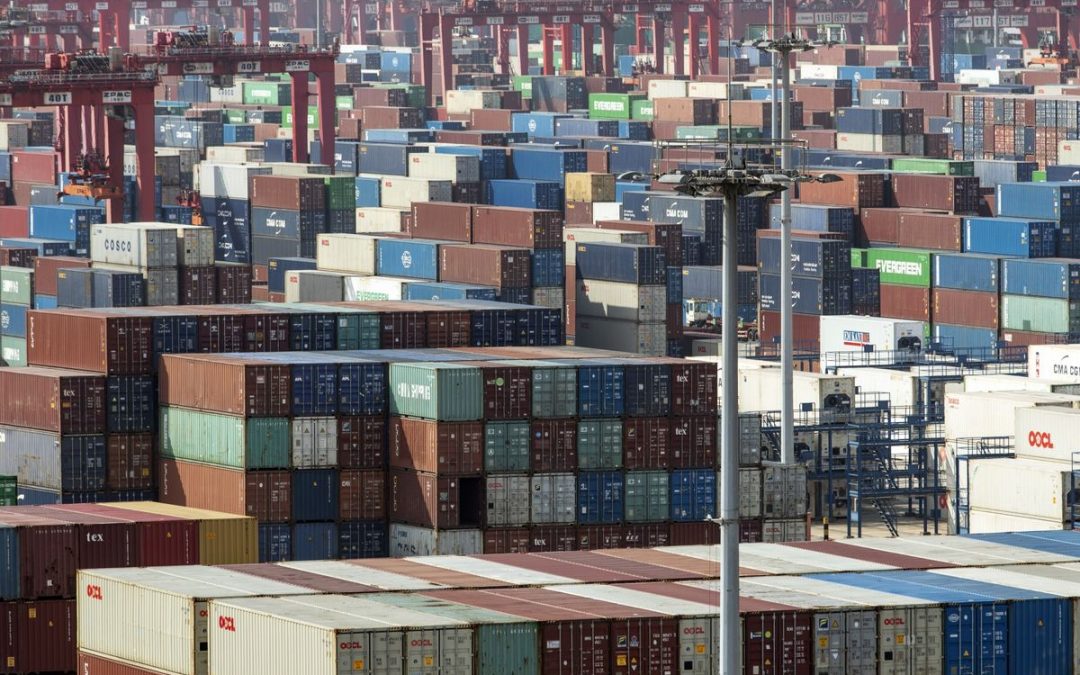Container shipping rates for North American imports have plummeted since the start of the year, with box volumes on the trans-Pacific route from China to the US West Coast having dropped 86.8% and US East Coast imports rates falling 71.6%, as of Dec. 6.
The bullish market at the end of 2021 and through the beginning of 2022 brought record-setting container box rates and was encouraged by weary shippers wanting to avoid the port congestion hurdles they faced in the first two years of the pandemic. Early shipments and increased volumes had unintended effects: further altering traditional import patterns, overfilling warehouses, and fostering ideal conditions for an unusually early and weak 2022 peak import season.
As of December, container box rates into both US coasts from North Asia have all but returned to pre-pandemic rates.
Platts Container Rate 13 (North Asia-to-West Coast North America) was assessed at $1,250/FEU Dec. 6, after it peaked at $9,500/FEU on Dec. 21, 2021, through March 3, data from S&P Global Commodity Insights shows. Before the pandemic began in January 2020, the route for WC North America-bound cargo from North Asia was at $1,650/FEU.
Similarly, Platts-assessed PCR5, which follows imports on the North Asia-to-East Coast North America at $3,100/FEU Dec. 6, slowly approaching a pre-pandemic rate of $2,850/FEU in January 2020, after reaching an all-time high rate of $12,000/FEU, where it stayed from March 24 through April 12.
Driving factors
Market participants attribute the drop to weakened buyer sentiment due to economic woes, overstocked warehouses from a volume boom in 2021 into early 2022, and increased carrier capacity to meet those volume needs.
The unusually high demand in the early stages of the pandemic put a strain on capacity and increased port congestion. Simultaneously, pandemic-related obstacles and union negotiations left ports understaffed and lacking equipment, resulting in the highest prices and longest dwell times the containers market had ever seen.
The adjacent ports of Los Angeles and Long Beach had an average dwell time of 41 days in 2021. In the same year, the Port of New York had the highest dwell time at 61 days on average, Container xChange data showed. Congestion at the Port of Los Angeles peaked in January with 109 vessels waiting in the queue. In February, TEU volumes at the Port of Los Angeles were still up 7.3% from 2021 and 57.7% from February 2020.
“When rates went up, people were desperate. Shelves were empty,” said a US-based freight forwarder. “Everything was out of stock and people were terrified of the situation repeating itself. People were panicking and not doing things strategically.”
Unintended outcomes
To avoid the import hurdles faced in 2021, many buyers moved up their 2022 holiday season shipments to summer. But these unusually early shipments further contributed to congestion, especially on the West Coast as negotiations with the International Longshoremen’s and Warehousemen’s Union continued.
The altered shipping pattern led to a surplus of goods – overstocking warehouses during the economy’s worst downturn since the pandemic began, with two consecutive quarters toting GDP losses. As consumers cut back, purchase orders began to slow, market sources said, and as consumer demand dropped, import volumes and rates were quick to follow suit.
As such, Hapag Lloyd’s latest quarterly report released in November, said worldwide container shipments are now expected to grow by only 1.1% in 2022 and 3.2% in 2023. Global shipments rose 7.1% in 2021, according to Container Trades Statistics.
“Shipments are at similar volumes as 2019,” said a second US-based freight forwarder. “The buying spree that everyone was excited about last year is over.”
Encouraging a coastal shift
As the US West Coast was plagued with congestion and equipment-related delays, many buyers migrated shipments to other ports on the US East and Gulf Coasts to improve consistency of delivery timelines.
When labor negotiations with the railroad union began mediation in June 2021, additional shippers hedged volumes by shifting more cargo to East Coast ports. When a rail strike was averted in early December, market sentiment improved significantly. However, some sources said shippers may not be quick to return to the West Coast, despite the Port of Long Beach announcing the complete ease of port congestion in late November.
October marked the third consecutive month in which TEU import volumes at the Port of New York and New Jersey eclipsed those at the Port of Los Angeles and the Port of Long Beach for the first time since spring of 2020.
While imports to the Port of New York and New Jersey did swell by 6.8% in Q3 2022 compared to the same period in 2021, they are still 4.5% less than the 5,600,194 TEU total import volumes at the Port of Los Angeles between October 2021 and October 2022, based on the latest data available from the Port of Los Angeles and the Port of New York.
A coastal shift after an early peak season
Uncertain future of a volatile market
A weak economy, high inflation, and low buyer sentiment were put forward as ingredients for the bearish market. Some market participants said the outlook for supply and demand finding a balance in the next two years is bleak.
“I can see inflation staying elevated, which will impact consumer spending significantly, so there is not light at the end of the tunnel where the supply and demand will meet an equilibrium,” said another freight forwarder. “I think supply will outweigh demand until 2024.”
Even a demand increase in 2023 would not be enough to equilibrize the additional vessel capacity that has come on to the market since 2019, explained the freight forwarder, who added “Even if that restocking happens in Q2 of 2023, what does it mean based on the additional capacity? Single-digit growth on volumes won’t do anything in the market.”
The additional capacity set to join the market in 2023 alarms a US-based consultant, who believes demand is waning.
“What’s going to happen to all of the new build vessels coming out?” the consultant said. “There is so much capacity coming onto the market and we’re trying to take capacity out now … We could be unbalanced for the next several years.”
Another market participant said the low demand, weak spot market and excess capacity are factors putting carriers in a defensive position.
“The challenge with carriers is that they need to face the reality,” said the source. “They have to step off the pedestal and step up to the negotiating table.”
At a recent Journal of Commerce webinar, shipping analyst and Vespucci Maritime CEO Lars Jensen said the global shipping market heading into 2023 is largely dependent on three things: inflation, the Russia-Ukraine war and consumer sentiment, adding that the future remains impossible to predict.
He said shippers who lock into contracts could see favorable rates if inflation increases, the war continues, and consumer sentiment remains low. However, if those variables improve, contracts could lock buyers into high terms when the spot market offers lower rates.
“This is not a 2023 where it’s about predicting what the rate is going to be,” Jensen said. “This is a 2023 where you need to contemplate: What is my risk management strategy that I want to pursue here longer term?”
Source: Hellenic Shipping News





